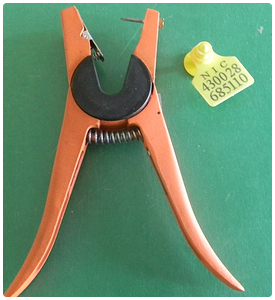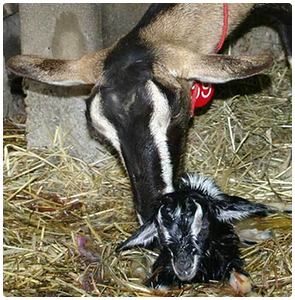|
Young stock Management
Colostrum feeding
- Colostrum is the first milk secreted after parturition.
- It contains large amount of Gama globulins which are anit-bodies produced by the ewe/doe against antigens encountered during her life including those against many disease producing organisms.
- Colostrums is highly fortified source of nutrient having seven times the protein and twice the total solids of normal milk, thus it gives an early boost in portion and solid intake.
- It contains higher amount of minerals and vitamin A which are essential to combat disease. Ingestion of these through colostrums substantially increases the kid/lamb’s survivability.
- Absorption of these antibodies provides the lamb/kid an umbrella of passive immunity.
- Colostrum give a laxative effect which is helpful in expulsion of muconium (first faeces).
- It will be highly useful to feed colostrum in the first 15-30 minutes after parturition.
Ear tagging
 |
 |
- Ear tagging is putting a tag in animal’s ear which enable identification of the animal thorough out its life.
- The tag should be inserted between the middle and lower cartilage ribs of the ear.
- It is best to place the tag as near to the head as possible to reduce the chances of ripping.
- The number should be on outside. Placing tags in different ears as to the animal’s sex help to sort the animals in large flocks.
- The main disadvantage of applying tag is that they may become snagged and the ear may tear which will lead to open wounds that can become infected.
- Sometimes the torn ear may be looking ugly and fetches low price in the market.
- To avoid this, tags applied should be neat and small. Initial identification of the animal may be done with ear tagging.
- The procedure for tagging is follows,
- Dip tag and applicator in disinfectant
- Write the number on the tag before tagging
- Restrain the animal in the standing position
- Clean the ear with methylated spirit
- Clip tag in to the ear with applicator avoiding ear veins.
Deworming
- The kids should be dewormed at the age of 3 months.
- In case of goats, the deworming should be done at an interval of 2 to 3 months.
- The deworming should be done with the advice of a veterinary doctor.
- The dewormers should be changed at a regular interval. Also the dewormer should be given according to the weight of the animal. Excess or low dosage and the repeating of deworming drug may develop “Drug resistance”. This may reduce the effect of our dewormer.
- Nowadays, combinations of dewormers are available for multiple worms. It is better to give combination of dewormer for multiple worms, than a specific worm.
- External parasites can be removed by allowing the animal for dipping.
- It will be better to avoid dipping in case of pregnant and sick animals.
Vaccination schedule for Sheep and goat
| Vaccine |
Age |
| Tetanus |
Immediately after birth |
| Foot and mouth disease |
At the age of 4 months, repeat again once in 6 months. |
| Sheep pox |
At the age of 3 months, repeat again once in a year. |
| Enterotoxaemia |
First vaccination-just before the weaning.
2nd vaccination-at 6 months of age, repeat once in a year. |
| Peste des petits ruminants |
At the age of 3 months, repeat once in a year. |
| Anthrax |
At the age of 6 months, repeat once in a year. |
| Blue tongue |
At the age of 3 months, repeat once in a year. |
Castration
- To render the animal docile, to control indiscriminate breeding and to prevent certain genital diseases castration is performed.
- It is also performed to induce faster gain in body weight and to improve the quality of meat.
- It is performed in young ones within 2-3 months through surgical method .
- In adult animals within one year of age, castration is performed through closed method using Burdizzo castrators.
- The Burdizzo castrator crushes the spermatic cord and thus stopping the blood to the testes and results in atrophy of the testes and stoppage of spermatozoa production.
- Castration should be performed during cold season Strictly avoid rainy season for fear of fly problems.
- Castrated kids should be rested for few days in clean and comfortable pens.
- Burdizzo castrator method is safe, quick and has less chance of getting infection.
- Elastrator rings are very painful to the animal and so it is not usually recommended.
Care and management of young ones
 |
- Immediately after the birth, mucous over the body surface and inside the nostrils should be thoroughly removed with a clean cloth.
- The kids/ lambs which are suffocating for respiration should be tilt upside down and few jerks can be made, for easy facilitation of respiration.
- Kids / lambs can be allowed with the mother and can be made her, to lick the young one.
- The naval cord should be cut by leaving 1 cm length, followed by the application of tincture iodine.
- The kids /lambs should be allowed to take the colostrum within 30 minutes after the birth.
- The kids / lambs should be protected from the cold at first two months of age.
- Dehorning can be done within 2 months after birth.
- To gain better weight, castration can be done for young animals.
- Vaccination should be done to the young kids / lambs , according to the vaccination schedule.
- The young kids / lambs at 3 months of age should be separated or weaned from the mother.
- Kid/lambs should be ensured to take sufficient colostrums with in 30 minutes after birth which give more resistance against diseases.
- Ensure proper suckling of lamb /kid
- Examine the udders for blindness of teats or mastitis.
- Take care of indifferent mothers and arrange suckling of lambs/ kids by restraing such type of ewes/ does
- Provide creep feed (good quality hay with or without concentrate mixture) to suckling lambs/ kidsin addition to suckling of milk from tenth day to weaning age.
- If possible make available green leguminous fodders or fresh tree leaves to lambs/ kids to nibble during sucking periods.
- Lambs/ kids may be ear- tagged or tattooed on the ear for identification.
- Tail docking and castration may also be done in first week or so by placing elastrator at inter vertebral space and not on the vertebra.
- During castration keep the lambs on perfectly dry, clean and hygienic site so as to minimize the risk of losses from tetanus and other infection.
- Normally kids/ lambs are playful; hence sufficient space should be there for movement.
- Salt lick or mineral block should be kept in the lamb pen to avoid licking of soil/floor.
- The new born should be protected from cold, wind and rain.
- Artificial milk feeding or arrangement of foster mother should be done for disowned or orphan lambs / kids
- Give a teaspoonful of castor-oil or liquid paraffin preferably mixed with little milk curd/ butter milk to lamb / kid to facilitate defecation and passing out of muconium easily and prevention of E.coli infection.
Weaning and care of weaners
- The management of weaners plays an important part in good sheep/ goat husbandry. The following steps are important in proper care and management of weaners.
- Weaning should preferably be done at 90 days, although in breeds with low milk production or where re-breeding is desired it can be done around 60 days.
- Supplementary feeding and good pasture for growing weaners should be provided.
- Weaned lambs / kids should be drenched against gastro-intestinal parasites by first month and vaccinated against enterotoxaemia and sheep pox.
- Weaners should not be grazed on poor burry and thorny types of pasture since it could cause skin irritation, injury to the eyes and dame to wool.
They should be protected against vagaries of climate and predation.
|